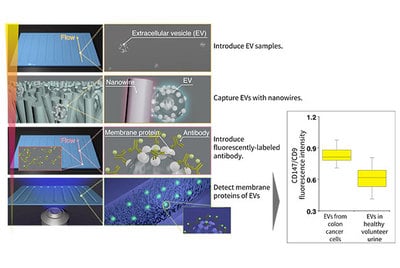Share this
Authors
Takao Yasui, Piyawan Paisrisarn, Takeshi Yanagida, Yuki Konakade, Yuta Nakamura, Kazuki Nagashima, Marina Musa, Ivan Thiodorus, Hiromi Takahashi, Tsuyoshi Naganawa, Taisuke Shimada, Noritada Kaji, Takahiro Ochiya, Tomoji Kawai, Yoshinobu Baba
Abstract
Extracellular vesicles (EVs) have shown promising features as biomarkers for early cancer diagnoses. The outer layer of cancer cell-derived EVs consists of organotropic metastasis-induced membrane proteins and specifically enriched proteoglycans, and these molecular compositions determine EV surface charge. Although many efforts have been devoted to investigating the correlation between EV subsets obtained through density-, size-, and immunoaffinity-based captures and expressed membrane proteins, understanding the correlation between EV subsets obtained through surface charge-based capture and expressed membrane proteins is lacking. Here, we propose a methodology to profile membrane proteins of EV subsets obtained through surface charge-based capture. Nanowire-induced charge-based capture of EVs and in-situ profiling of EV membrane proteins are the two key methodology points. The oxide nanowires allowed EVs to be obtained through surface charge-based capture due to the diverse isoelectric points of the oxides and the large surface-to-volume ratios of the nanowire structures. And, with the ZnO nanowire device, whose use does not require any purification and concentration processes, we demonstrated the correlation between negatively-charged EV subsets and expressed membrane proteins derived from each cell. Furthermore, we determined that a colon cancer related membrane protein was overexpressed on negatively charged surface EVs derived from colon cancer cells.

URL:https://www.sciencedirect.com/science/article/pii/S0956566321006266?via%3Dihub
These Related Stories